
The King's Regiment (Liverpool) was one of the oldest line infantry regiments of the British Army, having been formed in 1685 and numbered as the 8th (The King's) Regiment of Foot in 1751. Unlike most British Army infantry regiments, which were associated with a county, the King's represented the city of Liverpool, one of only four regiments affiliated to a city in the British Army. After 273 years of continuous existence, the regiment was amalgamated with the Manchester Regiment in 1958 to form the King's Regiment (Liverpool and Manchester), which was later amalgamated with the King's Own Royal Border Regiment and the Queen's Lancashire Regiment to form the present Duke of Lancaster's Regiment (King's, Lancashire and Border).
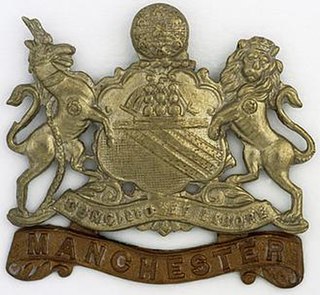
The Manchester Regiment was a line infantry regiment of the British Army in existence from 1881 until 1958. The regiment was created during the 1881 Childers Reforms by the amalgamation of the 63rd Regiment of Foot and the 96th Regiment of Foot as the 1st and 2nd battalions; the 6th Royal Lancashire Militia became the 3rd (Reserve) and 4th battalions and the Volunteer battalions became the 5th, 6th, 7th, 8th, 9th and 10th battalions.

The Royal Scots, once known as the Royal Regiment of Foot, was the oldest and most senior infantry regiment of the line of the British Army, having been raised in 1633 during the reign of Charles I. The regiment existed continuously until 2006, when it amalgamated with the King's Own Scottish Borderers to become the Royal Scots Borderers, which merged with the Royal Highland Fusiliers, the Black Watch, the Highlanders and the Argyll and Sutherland Highlanders to form the Royal Regiment of Scotland.
The 2003 Defence White Paper, titled Delivering Security in a Changing World, set out the future structure of the British military, and was preceded by the 1998 Strategic Defence Review (SDR) and the 2002 SDR New Chapter, which responded to the immediate challenges to security in the aftermath of the September 11 attacks in 2001. Published under the then Secretary of State for Defence, Geoff Hoon, the report effectively introduced a series of cutbacks to core equipment and manpower and the scaling back of a series of future capital procurement projects. This was justified due to the implementation of a policy termed Network Enabled Capability. The review also outlined a major restructuring and consolidation of British Army Infantry regiments.
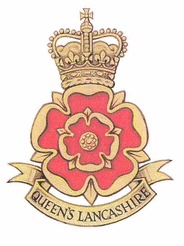
The Queen's Lancashire Regiment (QLR) was an infantry regiment of the British Army, part of the King's Division. It was formed on 25 March 1970 at Connaught Barracks in Dover through the amalgamation of the two remaining Lancashire infantry regiments, the Lancashire Regiment and the Loyal Regiment. In July 2006 the regiment was amalgamated with two other Northern infantry regiments to form the Duke of Lancaster's Regiment.

The King's Own Royal Border Regiment was an infantry regiment of the British Army in existence from 1959 until 2006, and was part of the King's Division. It was formed at Barnard Castle on 1 October 1959 through the amalgamation of the King's Own Royal Regiment (Lancaster) and the Border Regiment.
The Rifles is an infantry regiment of the British Army. Formed in 2007, it consists of four Regular battalions and three Reserve battalions. Each Regular battalion of The Rifles was formerly an individual battalion of one of the two large regiments of the Light Division. Since formation, the regiment has been involved in combat operations in the later stages of the Iraq War and in the War in Afghanistan.
The Lancastrian and Cumbrian Volunteers was a Territorial Army unit of the British Army.
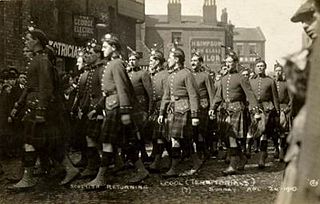
The Liverpool Scottish, known as "the Scottish", was a unit of the British Army, part of the Army Reserve, raised in 1900 as an infantry battalion of the King's. The Liverpool Scottish became affiliated to the Queen's Own Cameron Highlanders in the 1920s and formally transferred to the regiment in 1937 with its identity preserved. Reflecting the Territorial Army's decline in size since the late 1940s, the battalion was reduced to a company in 1967, then to a platoon of "A" (King's) Company, King's and Cheshire Regiment in 1999. In 2006, the company was incorporated into the 4th Battalion, Duke of Lancaster's Regiment.
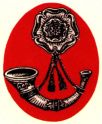
The Liverpool Rifles was a unit of the Territorial Army, part of the British Army, formed in Lancashire as a 'Rifle Volunteer Corps' (RVC) in 1859, becoming a battalion of the King's Regiment (Liverpool) in 1881. It saw action on the Western Front in the First World War and later became a searchlight unit of the Royal Artillery in the Second World War.
The Liverpool Irish is a unit of the British Army's Territorial Army, raised in 1860 as a volunteer corps of infantry. Conversion to an anti-aircraft regiment occurred in 1947, but the regimental status of the Liverpool Irish ceased in 1955 upon reduction to a battery. Since 1967, the lineage of the Liverpool Irish has been perpetuated by "A" Troop, in 208 Battery, 103rd Regiment. The 103rd has provided individual reinforcements to regular artillery regiments equipped with the AS-90 and L118.

The Warwickshire Yeomanry was a yeomanry regiment of the British Army, first raised in 1794, which served as cavalry and machine gunners in the First World War and as a cavalry and an armoured regiment in the Second World War, before being amalgamated into the Queen's Own Warwickshire and Worcestershire Yeomanry in 1956. The lineage is maintained by B Squadron, part of The Royal Yeomanry.
The Lancastrian Brigade was an administrative formation of the British Army from 1948 to 1968. The Brigade administered the regular infantry regiments of northwest England.
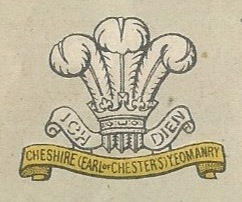
The Cheshire Yeomanry was a yeomanry regiment that can trace its history back to 1797 when Sir John Leicester of Tabley raised a county regiment of light cavalry in response to the growing fears of invasion from Napoleonic France. Its lineage is maintained by C Squadron, the Queen's Own Yeomanry.
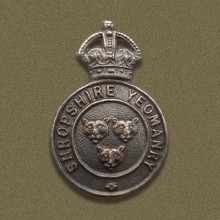
The Shropshire Yeomanry was a yeomanry regiment of the British Army, first raised in 1795, which served as a cavalry and dismounted infantry regiment in the First World War and as a cavalry and an artillery regiment in the Second World War. It was then amalgamated with the Shropshire Royal Horse Artillery.

The 127th (Manchester) Brigade was an infantry brigade of the British Army that saw active service during both the First and Second World Wars. It was assigned to the 42nd Division and served in the Middle East and on the Western Front in the First World War.
The Liverpool Brigade, later 165th (Liverpool) Brigade was an infantry brigade of Britain's Volunteer Force that served during World War I with the 55th Division of the British Army. During World War II, again as part of the 55th Infantry Division, the brigade remained in the United Kingdom.
The Lancastrian Volunteers was a short lived Territorial Army infantry regiment of the British Army, composed of companies from the North West affiliated regiments.

The 5th Battalion, King's Regiment (Liverpool) was a volunteer unit of the King's Regiment (Liverpool) of the British Army. It traced its heritage to the raising in 1859 of a number rifle volunteer corps in Liverpool, which were soon consolidated into the 1st Lancashire Rifle Volunteer Corps (RVC). It was affiliated to the King's Regiment (Liverpool), and became its 1st Volunteer Battalion of the regiment. In 1908 the battalion was transferred to the new Territorial Force as the 5th Battalion, King's Regiment (Liverpool). It saw active service on the Western Front during World War I, as did its second line second-line battalion, and even a garrison battalion. Before World War II it again formed a second line battalion. Both served in home defence, but the 5th King's landed in Normandy on D Day as part of a specialist beach group 1939. When the Territorial Army was reduced in 1967, the 5th King's became a company of the Lancastrian Volunteers.













